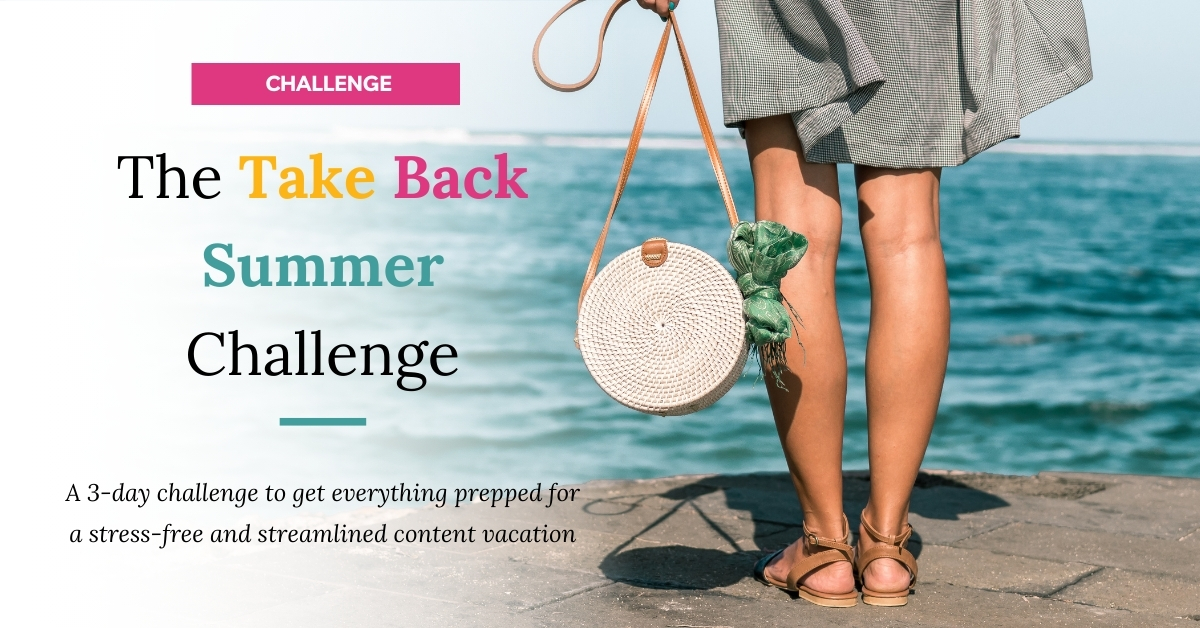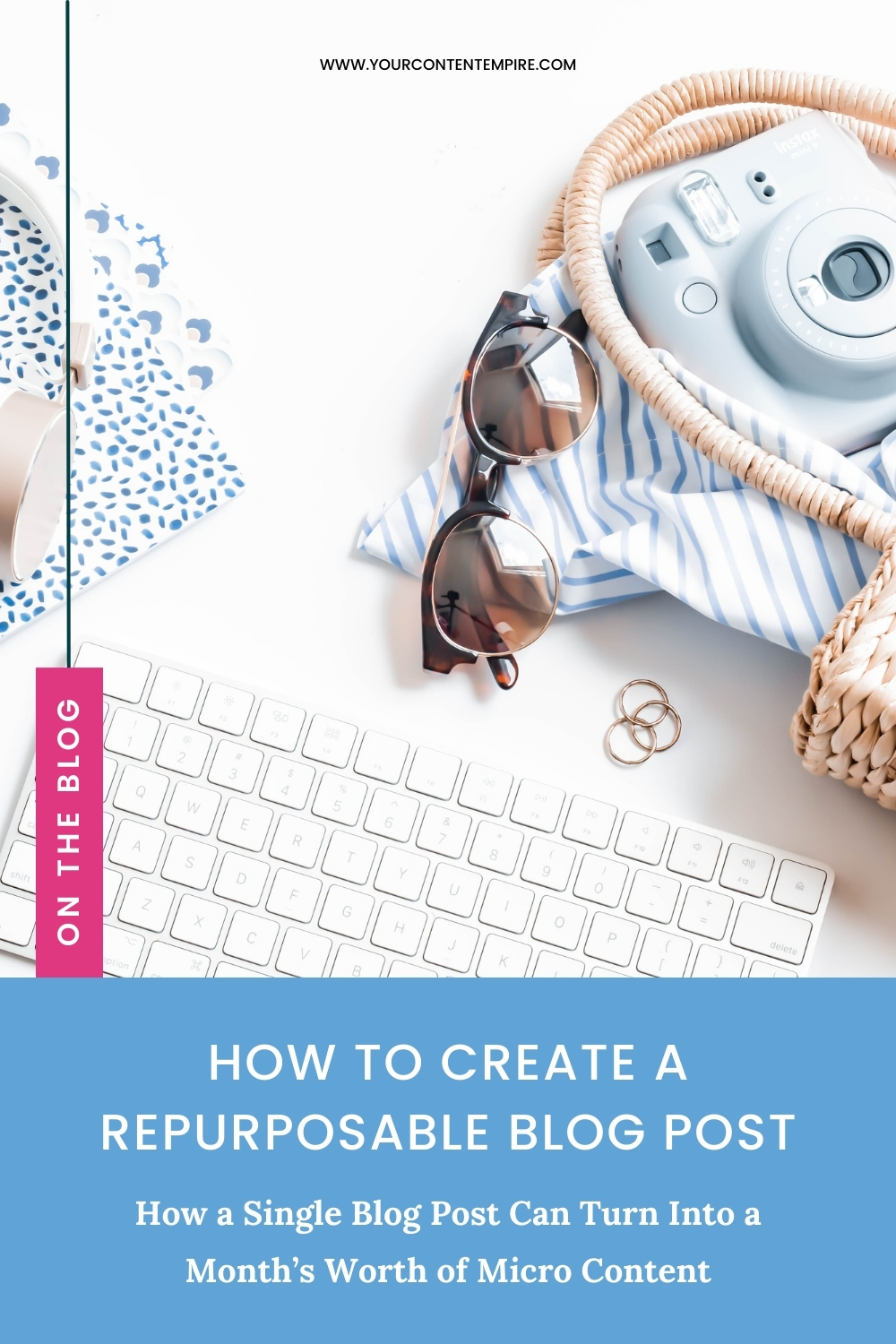
Sign up to sign up for the challenge (May 14th to 16th)!
Want more profitable + strategic content? Grab my free content planner!


I’m Hailey – content strategist and founder here at Your Content Empire where we help you create more profitable, purposeful and productive content — and hopefully enjoy yourself more while doing it too. Learn more about me here >>

There’s a lot of talk about repurposing content. But truth be told, not all content is easy to repurpose. The juicier the post, the more you’re able to squeeze it into new forms. So what makes a repurposable blog post?
A simple standard? It’s usually on the longer side and consists of multiple sections. And each of those sections contain standalone messages and hooks.
When you’re starting with a highly repurposable piece of content, the repurposing potential is endless, including:
To wow you with a little math, assuming 3 standalone sections, we’re talking 31-34 different pieces of content from a single source.
So are you ready to come to the repurposable side of the internet? Here’s the 3 key ingredients to a repurposable piece of content.
The first element of a highly repurposable piece of content comes before you actually create it. It starts with your outline. Generally (although there have been some exceptions with people who are really good at winging it on live videos), the best repurposable content I’ve created and received from clients to work with have been created with an intentional outline where each section is carefully thought through.
I have a few recommendations on how to create your outline:
#1 – Get Purpose-Driven
Start by getting clear on the purpose of the piece of content for yourself (the brand/business) and the content consumer (reader/watcher/listener).
Ask yourself: What is the purpose of this piece of content for me? What do I want people to do after consuming it? What is my call-to-action (CTA)?
Then ask yourself: What is the purpose of this piece of content for my audience? What will they gain from reading, watching or listening to it? What are their biggest takeaways? What are their goals for watching it?
#2 – Get Inquisitive
Once you have purpose on point, ask yourself: What are the questions this piece of content has to answer in order to deliver on those purposes? Ideally you want anywhere between 3-7 questions that could all be standalone sections in your content piece.
These questions might be in the form of different things to think about when approaching this topic (take this blog post, for example, which has 4 sections: The Power of Repurposable Content, A Repurposable Outline, A Repurposable Section, Repurposable No Matter What Format). Or they could be steps of an overall process.
#3 – Get Responsive
Once you’ve got the questions, it’s time to get the answers. For each question, write down at least 5 answer bullet points, plus jot down how the section (aka the question) relates to the overall topic and how the section (aka the question) could be read, watched or listened to as a solo piece of content (without the context from the rest of the post).
The next component of a highly repurposable piece of content is to make sure that each section is optimized to repurpose.
The key thing is to make sure each piece: (1) delivers enough value on it’s own; and (2) can stand on its own and be understood without the context from the other sections around it.
Sometimes you might need to do a little rejigging to detangle it from the other sections, which is okay but just something to be aware of.
Here’s a little 3-part checklist to make each section repurposable:
☐ Create a hook for each section (what’s the thing that’s going to grab the attention of your audience when they read, watch or listen to it)
☐ Identify what pieces can be repurposed from the section into new pieces of content (number and types)
☐ Decide what needs to be added or removed to make this section stand on it’s own
Sometimes I’ll get “yes, buts…” when talking about creating repurposable content and it usually has to do with perceived limitations on the type of content they’re creating – like written versus podcasts versus video.
But you can really find a way to repurpose no matter what format.
Here’s a little “repurposable no matter what format” gameplan.
For Written Content: Create your outline and write each section with repurposing in mind (see previous sections for how). Then your written content can be repurposed as standalone microblogs, carousels, reels. Or if you ever want to expand to a new format (podcast or video), you can use your written blog as a base script.
For Podcast Content: Record your podcast after creating an outline with distinct sections or subtopics you’ll cover. Get a transcript of your podcast and clean it up. Just like with written, you can use the text as standalone microblogs, carousels, reels. But you can also use the audio sections as audiograms or micro podcasts or direct reels with your podcast as the sound.
For Video Content: Video content probably offers the most versatility when it comes to repurposing. In addition to all of the repurposing strategies covered already for written and podcast content, you can also use your video to create reels, shorts, video pins and TikToks.
The exact repurposing workflow is something that develops through doing, so just make sure to take a little extra time your first 3-5 times you’re figuring the process out to document your workflows and notes. That way, you’ll not only have repurposed content but also have your SOPs ready to start saving time with outsourcing or batching like tasks together.
My upcoming FREE upcoming challenge will help you get prepped for a stress-free and streamlined content vacation whether it’s a short or long one. Sign up here↓
Ever catch yourself thinking "marketing used to be so much easier" or “my marketing stopped working!” You're not imagining it. Between plummeting social media reach, AI-generated content flooding your feed, and a world that seems to serve up a new crisis every...
Want to know the #1 reason why most people fail at content marketing? It's not what you think. It's not about lacking creativity, having writers block, or even being too busy... It's about being stuck in your own head. I'm going to show you a ridiculously simple...
Tired of staring at a blank screen, wondering what to post? What if I told you I create 260+ pieces of content every year without breaking a sweat? Today, I'm giving away my entire daily writing system – the exact process I use to never run out of ideas and...